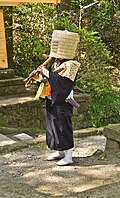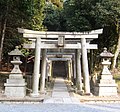Tōfuku-ji
This article includes a list of general references, but it lacks sufficient corresponding inline citations. (March 2010) |
| Enichisan Tōfuku-ji | |
|---|---|
 The hon-dō (Main Hall) | |
| Religion | |
| Affiliation | Rinzai and Fuke Zen, Tōfuku-ji school |
| Deity | Śākyamuni (Buddha) |
| Location | |
| Location | 15-778 Honmachi Higashiyama-ku, Kyōto-shi, Kyōto-ken |
| Country | Japan |
| Architecture | |
| Founder | Kujō Michiie |
| Completed | 1236 |
| Website | |
| http://www.tofukuji.jp/ | |
| Part of a series on |
| Komusō |
|---|
 |
| People |
|
| Philosophy |
| Places |
|
| Topics |
| Literature |
|
Tōfuku-ji (東福寺) is a Buddhist temple in Higashiyama-ku in Kyoto, Japan. Tōfuku-ji takes its name from two temples in Nara, Tōdai-ji and Kōfuku-ji.[1] It is one of the so-called Kyoto Gozan or "five great Zen temples of Kyoto". Its honorary sangō prefix is Enichi-san (慧日山).
History
Tōfuku-ji was founded in 1236 by the imperial chancellor Kujō Michiie.[2] He appointed the monk Enni as founding priest, who had studied Rinzai Zen Buddhism in China under the monk Wuzhun Shifan. The temple was burned but rebuilt in the 15th century according to original plans. Tofuku-ji was one of the five temples of the Five Mountain System.
Abbots
In 1486 Ryōan Keigo became the 171st abbot of Tōfuku-ji. At the end of the 16th century Ankokuji Ekei was appointed abbot. From 1980 to 2009 Tōfuku-ji has been led by head abbot Keidō Fukushima.[3]
Architecture

Tōfuku-ji's main gate is the oldest sanmon in Japan. It is a National Treasure of Japan. It is two stories high and five bays wide. The central three bays are doors.
Currently, the Tōfuku-ji complex includes 24 sub-temples, though in the past the number has been as high as 53.
Artwork
Tōfuku-ji's large nehan-zu painting depicts Buddha on his death bed. This massive image (7 x 14 meters) is the second largest in Japan. The image at nearby Sennyū-ji is the largest of its kind in Japan, measuring 8 x 16 meters. Both images are rarely displayed, most recently in 2003 for three days only.[4]
A 1238 portrait painting of Wuzhun Shifan along with an inscription by an anonymous author was brought to the temple by Enni in the 1240s and remains there today. Plaques of Wuzhun's calligraphy is also kept at Tōfuku-ji.
In 1933 the Nihonga painter Inshō Dōmoto painted the large and vivid "Blue Dragon" ceiling painting for one of the halls, which he painted in 17 days.[5]
Garden

There are a number of gardens in the various precincts of Tōfuku-ji. The current garden was designed by landscape architect Mirei Shigemori in the 1930s. The moss garden in particular has been emblematic of the renewal of Japanese gardening principles in the 20th Century.
The temple features a large number of Japanese maple trees, and is most crowded during the autumn season when people flock to see the autumn foliage. It is a tradition to view the leaves from the Tsūten-kyō bridge.
Images
-
Main gate, side view
-
View from interior
-
Scenic drawing of Tsūten-kyō bridge, by Hiroshige
-
Tsuten-kyō bridge during autumn
-
Tsūten-kyō
-
Dry Zen garden at Reiun-in
-
Garden at Kaizandō
-
Garden at Ryoginan-tōtei
-
Torii gates leading to steps
-
Steps
-
Main hall
-
Kaizandō
See also
- Zen
- Enni
- Wuzhun Shifan
- List of Buddhist temples
- List of Buddhist temples in Kyoto
- List of National Treasures of Japan (temples)
- List of National Treasures of Japan (paintings)
- List of National Treasures of Japan (writings)
- For an explanation of terms concerning Japanese Buddhism, Japanese Buddhist art, and Japanese Buddhist temple architecture, see the Glossary of Japanese Buddhism.
Notes
- ^ Japan Reference: Tōfuku-ji
- ^ Ponsonby-Fane, Richard. (1956). Kyoto: The Old Capital of Japan, 794-1869, p. 152.
- ^ Harris, Ishwar C. et al. (2004). The Laughing Buddha of Tofukuji: The Life of Zen Master Keidō Fukushima, p. xi.
- ^ "Kansai: Who -- What: Giant Buddhas shown for three days only," Japan Times Online. March 9, 2003.
- ^ http://www.kyoto-magonote.jp/en/zen-2016/zen-2016.html
References
- Baroni, Helen Josephine. (2002). The Illustrated Encyclopedia of Zen Buddhism. New York: Rosen Publishing Group. ISBN 978-0-8239-2240-6; OCLC 42680558
- Dumoulin, Heinrich. (2005). Zen Buddhism: A History (Vol. II: Japan). Bloomington, Indiana: World Wisdom. ISBN 978-0-941532-90-7
- Fukushima, Keidō and Fumi Dan. (2006). Tōfukuji. Kyoto: Tankōsha. ISBN 978-4-473-03353-6; OCLC 145752382
- Harris, Ishwar C. and Jeff Shore. (2004). The Laughing Buddha of Tofukuji: The Life of Zen Master Keidō Fukushima. Bloomington, Indiana: World Wisdom. ISBN 978-0-941532-62-4; OCLC 56051074
- Ponsonby-Fane, Richard Arthur Brabazon. (1956). Kyoto: The Old Capital of Japan, 794-1869. Kyoto: The Ponsonby Memorial Society.
External links
- Tōfuku-ji official web site
- Kyoto Prefectural Tourism Guide: Tōfuku-ji
- Joint Council for Japanese Rinzai and Obaku Zen: Tōfuku-ji
- Buddhist Travel: Tōfuku-ji
- Pictures of Tōfuku-ji
34°58′27″N 135°46′25″E / 34.97417°N 135.77361°E












